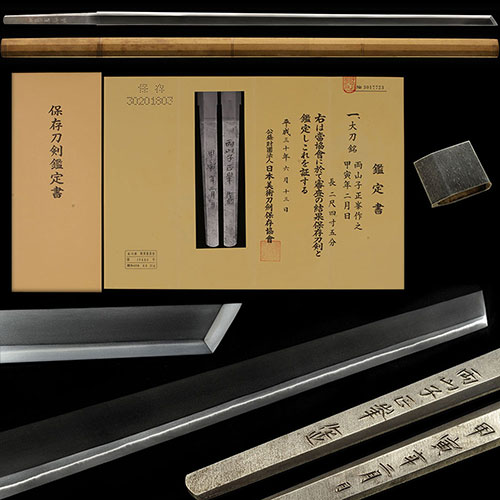
両山子正峯 太刀Ryouzanshi Masamine Tachi
No.693657太刀 人間国宝 両山子正峯作之 伊勢神宮式年遷宮太刀影打 丸棟切刃造直刀 二尺四寸五分 Tachi Ningenkokuho(Living National Treasure) Ryouzanshi Masamine Korewo Tsukuru IseJingu Shikinen Sengu Tachi Kageuchi Marumine Kirihadukuri Chokutou 74.3cm
ご成約Sold
- 銘表Mei-Omote
- 両山子正峯作之 両山子正峯作之 Ryouzanshi Masamine Korewo Tsukuru
- 裏銘Ura-mei
- 甲寅年二月日甲寅年二月日 February day of Kouin
- 登録証Registration
- 石川県 Ishikawa 昭和49年8月21日 8/21/49(Showa)
- 時代Period
- 昭和Syouwa
- 法量Size
-
刃長 74.3cm (二尺四寸五分 ) 反り 0.0cm
元幅 2.5cm 先幅 1.9cm 元重 0.48cm 鎬厚 0.49cm 先重 0.36cm 鋒長 1.6cm 茎長 17.4cm 重量 540gHachou 74.3cm (二尺四寸五分 ) Sori 0.0cm
Moto-Haba 2.5cm Saki-Haba 1.9cm Moto-Kasane 0.48cm Shinogi-Thikess 0.49cm Saki-Kasane 0.36cm Kissaki-Chou 1.6cm Nakago-Chou 17.4cm Weight 540g - 姿Shape
- 切刃造、丸棟。Kirihadukuri, Marumine
- 鍛Kitae
- 小板目肌つみ、地沸微塵につき、地景細かくよく入り、鉄明るく冴える。Small-Itamehada-tsumi, Jinie entered finely, Chikei entered finely well, Iron is bright and clear.
- 刃文Hamon
- 細直刃に、小沸つき、小足入り、匂口締まりごころに明るい。Hososuguha, Small-Nie-tsuki, Small-Ashi enter, Nioikuchi shimarigokoro is bright.
- 帽子Boushi
- 直ぐに小丸。Suguni-Komaru
- 茎Nakago
- 生ぶ、先栗尻、鑢目勝手下り化粧、目釘孔なし。Ubu, Sakikurijiri, Yasurimekattesagari-Kesyou, No Mekugiana
- ハバキHabaki
- 銀無垢一重。Solid silver single layer.
- 説明Drscription
- 正峯は大正十年石川県に生まれ、本名を隅谷与一郎と言い、立命館大学を卒業後、桜井正幸刀匠に学び、昭和十七年には広島県にある興国日本刀鍛錬場に入る。戦後は昭和三十年に、鍛錬所「傘笠亭(さんりゅうてい)」を郷里に構え、傘笠亭、傘笠、両山子とも号している。翌同三十二年から八年間新作刀展で連続入賞、同四十一年、四十二年と連続で正宗賞の栄誉に輝き無鑑査刀匠指定、同五十六年には重要無形文化財指定を受ける。平成十年、七十七歳没。主な作品に、伊勢神宮式年遷宮御神宝纏御太刀(昭和39年)、伊勢神宮式年遷宮御神宝太刀十二振(同44年)、伊勢神宮式年遷宮御神宝太刀十六振(平成元年)のほか、皇太子妃、秋篠宮真子内親王の守り刀などがある。飛鳥・奈良時代から現代にいたる刀剣技術を研究し、なかでも鎌倉期の一文字や長船長光、青江などを得意とした。
本作は、昭和四十四年伊勢神宮式年遷宮御神宝太刀の影打ちに、昭和49年に銘を切ったものと思われる。鉄美しくつみ、地刃冴える名品である。Masamine(Seihou) was born in Ishikawa Prefecture in 1914. His real name is Yoichiro Sumiya. After graduating from Ritsumeikan University, he studied under Masayuki Sakurai, a swordsmith, and in 1932 entered the Kokoku Japanese Sword Forging Shop in Hiroshima Prefecture. After the war, in 1955, he set up a training center 'Sanryutei' in his hometown, also calling himself Kasasasatei, Kasagasa, and Ryoyamako. The following year, in 1956, he won prizes at the New Sword Exhibition for eight years in a row, and in 1941 and 1942, he was honored with the Masamune Prize, becoming a swordsmith without inspection. receive property designation. In 1998, he died at the age of seventy-seven. Major works include Ise Jingu Shikinen Sengu Sacred Treasure Sword (1964), Ise Jingu Shikinen Sengu Sacred Treasure 16 Swords (1969), Ise Jingu Shikinen Sengu Sacred Treasure 16 Swords (1964) 1989), as well as the protective swords of the Crown Princess and Princess Mako of Akishinonomiya. He studied sword techniques from the Asuka and Nara periods to the present day, and was especially good at Ichimonji, Osafune Nagamitsu, and Aoe during the Kamakura period.
This work is thought to have been inscribed in 1974 on the shadow of the Ise Jingu Shikinen Sengu Goshinpo Tachi Kageuchi in 1969. It is a masterpiece with beautiful Iron-tsumi Jiba is clear.


